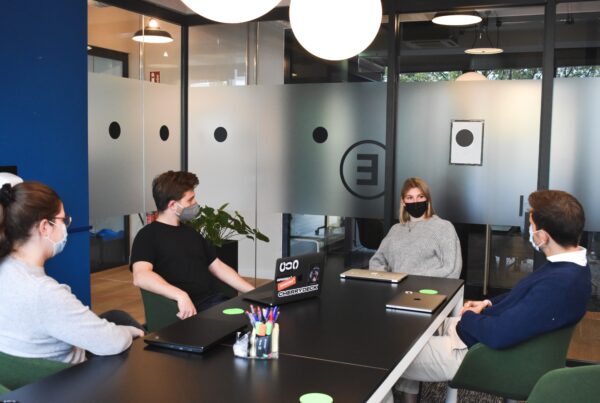Think of workplace inclusivity, and you’ll probably envision an office filled with people of different ages, ethnicities, religions and lifestyles. Sound about right?
In actual fact, achieving a truly inclusive workplace involves a little more than putting together a team of people with diverse lifestyles, cultures and backgrounds – though that’s a great start.
So, let’s dig a little deeper into just what we mean by workplace inclusivity, what benefits it brings, and how to achieve it.
Diversity vs inclusivity
These two terms are often used interchangeably, but there’s a subtle yet important difference. While diversity is about assembling a team of people with different viewpoints, inclusivity is about engaging with and celebrating those differences. It’s diversity put into action, if you like.
So, while a diverse workplace would feature employees from different countries, religions, ways of life, sexual orientations, etc., an inclusive workplace makes sure everyone within that group feels accepted and valued.
Why is inclusivity important?
We can answer this one on both a personal and a business level. The personal and social arguments for inclusivity are easy to see: the world becomes a nicer, easier place to be when we support each other, hear each other out and respect each other’s viewpoints. That spirit of listening to and welcoming different viewpoints makes for a happier environment, whether we’re talking about a family, a football team, or a financial services company.
However, embracing the spirit of inclusivity will also benefit your business. The Boston Consulting Group surveyed more than 1,700 companies and found that those who were more diverse than the average managed 19% higher innovation revenues (the proportion of revenues brought in by brand new products or services). Meanwhile, a 2018 McKinsey report revealed that firms with the most ethnically and culturally diverse boards were 43% more likely to experience higher profits than their more homogenous counterparts. A study by Cloverpop also discovered that when diverse teams arrived at decisions together, they performed better than lone decision-makers in almost 87% of scenarios.
In short, a team in which everyone’s thoughts and perspectives are heard is going to make for both a happier and a more effective workplace. So, how to achieve this optimum inclusivity? Here are a few key steps to take towards a truly inclusive workplace.
-
Engage with your staff
If you want to create an inclusive workplace, you can lead by example and start by examining your own relationships with those around you. Do you feel that you interact in a friendly and open manner with your staff? Do you believe they feel comfortable voicing their opinions around you? You want everyone to feel their voice is welcome and can be heard – and this should start with how they feel about speaking up around you and other senior leaders.
-
Keep an open mind
Again, this one is a case of leading by example. If you can put your own stereotypes and assumptions aside, and grant everyone on your team the same open-minded attention, this will inspire everyone around you to do the same. Be aware that your own attitude towards different viewpoints will act as a kind of barometer, indicating to everyone what thoughts, ideas and issues can be spoken out loud at your company. Be open to the opinions of others, and show a willingness to adapt, and you’ll find that attitude ripples out from you.
-
Educate your leaders
After yourself, the next group of people who need to lead from the front on inclusivity will be your executives and managers. Some form of inclusivity training for senior leaders will be a huge benefit to your company. Start at the beginning: what inclusivity is, and why it’s important.
You may then want to go on to cover topics such as unconscious bias – when people unwittingly make judgments about others based on gender, race or other factors. From here, you can encourage everyone to practise active listening, and to welcome different points of view. Also focus on more practical areas where inclusivity will make a difference to employees’ work-life balance, such as helping single parents with childcare issues.
-
Form an ‘inclusivity council’
You can really help your ideas about inclusivity to percolate right through your workplace culture by forming an inclusivity council, featuring a handful of influential members of staff. You need people who show a real commitment to the inclusivity cause – and who can be a channel of communication between the workforce and the boardroom.
This council can set goals around hiring, retaining and nurturing a truly diverse workforce – and address any current inclusivity issues, such as underrepresented employee groups or lack of provision for certain cultural, religious or other needs.
It goes without saying that this inclusivity council should be as diverse as possible, featuring a range of genders, ethnicities and roles.
-
Celebrate difference
Remember that a truly inclusive workplace won’t just hear a variety of views, it will actively engage with them. It won’t just tolerate differences of outlook and lifestyle, but will go right ahead and celebrate them.
So why not invite your employees to share their traditions with the rest of the team? That way, they get to feel more included, and everyone learns a little more about the world around them and about the things that are important to the people they work next to every day.
Consider training your team in cultural diversity. This can be as simple as holding a monthly workshop on topics such as gender identity, mental health, or social stereotyping.
-
Promote inclusivity everywhere
Rather than hoping that it gradually develops its own momentum, you need to champion inclusivity at your workplace, making it a visible priority everywhere you look. For example, include it as a core value of your company in any onboarding material or activities for new employees, so they know right from the get-go that inclusivity is taken seriously, and that they need to embrace all views and positions.
Flag it up on your website, too: diversity and inclusivity will be high up on the job shopping list for many of today’s applicants, so you may well attract more and/or better applicants by showing your commitment to the cause.
-
Listen
Ensuring that your staff feel heard, understood and valued is a key milestone on the journey to inclusivity. Employee surveys, focus groups, regular informal ‘everything on the table’ sessions: these are all great ways to hear what’s concerning your workforce and to start to make the changes they need.
Better still, once your staff understand that you’re committed towards a culture where everyone is heard and valued, they’ll soon adopt this mindset too – making for a happier, more welcoming workplace for everyone.
We can help you achieve greater inclusivity – and a happier workplace
The various services we offer at Jefferson Talent Group include our health and wellbeing workshops, a series of fun, engaging workshops and resources that can help improve the outlook, energy, and performance of your employees. Programmed in tandem with some of the inclusivity initiatives we’ve discussed above, these could go a long way towards achieving that happy, busy workplace where everyone feels understood, valued – and ready to give their very best.
Contact us to find out more.










